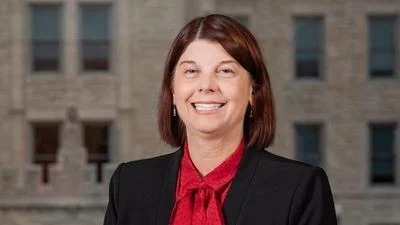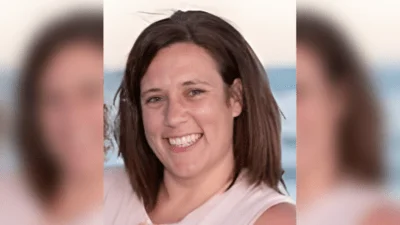Mary Cozad, County Board Member | DeKalb County
Mary Cozad, County Board Member | DeKalb County
DeKalb County Committee of the Whole met Nov. 1.
Here are the minutes provided by the committee:
The Committee of the Whole of the DeKalb County Board met in Sycamore, Illinois on Wednesday, November 1, 2023. Chair Suzanne Willis called the meeting to order at 6:30pm. Those Members present were Tim Bagby, Scott Campbell, Mary Cozad, Rukisha Crawford, Patrick Deutsch, Meryl Domina, Laurie Emmer, John Frieders, Benjamin Haier, Rhonda Henke, Kathy Lampkins, Maureen Little, Jim Luebke, Terri Mann-Lamb, Joseph Marcinkowski, Stewart Ogilvie, Jerry Osland, Michelle Pickett, Roy Plote, Chris Porterfield, Amber Quitno, and Ellingsworth Webb. A quorum was established with twenty-three Members present, one absent.
APPROVAL OF THE AGENDA
Porterfield moved to approve the agenda as presented. Crawford seconded the motion.
PUBLIC COMMENTS
Anna Wilhelmi encouraged the County Board to provide the DeKalb County Rehab & Nursing Center with sufficient funding to recover from stagnation that occurred during the sale process.
Carol Deemer reminded the County Board that lack of oversight of the DCRNC’s management company was the reason for the current financial problems and requested that the County Board keep a close eye on the facility. She explained that the increased industrial growth within DeKalb County should provide sufficient revenue to support the operations of the DCRNC.
Madelyn Nelson asked the County Board to fund the DCRNC without haggling and to provide long-term, tax-funded support to the DCRNC.
CHAIR’S COMMENTS
Chair Willis expressed that as the County Board continues to discuss how to fund the DCRNC’s anticipated budgetary deficit, County Board Members need to commit to existing employees, meaning no jobs will be cut and not providing annual cost of living adjustments is off the table. She insisted that the County Board needs to find a way to fund the DCRNC that is not on the backs of existing employees.
PRESENTATIONS/DISCUSSIONS
Presentation of DCRNC Business Plans by Jordan Healthcare
County Administrator Brian Gregory introduced Andrew Cutler, Thomas Annarella, and Jeremy Brune, representatives of Jordan Healthcare Group, who have been providing consulting services for the DCRNC since early 2022. Gregory thanked them for their continued work and assistance with the operations of the DCRNC.
Cutler explained that in August of this year, Jordan Healthcare Group (JHG) began developing a Business Plan Model that would be implemented if the sale of the DCRNC were to not occur. He provided an overview of the problems that the facility has faced over the last number of years, as well as some of the current challenges that the facility is still facing. He explained that one of the major issues that the DCRNC will need to correct if the JHG Business plan were to be implemented is the Charge and Reimbursement structures.
Cutler explained that while reviewing the facility’s 2022 Cost Report, he discovered that there was a missed rate opportunity with Medicaid. He explained that the County could be reimbursed by Medicaid for settlement money, which equates to approximately $14 per patient day in Medicaid Reimbursement Lost, which at current census, that equates to $360,000. Cutler noted that JHG is working to get this corrected in the 2024 rate with HFS.
The suggested change that Cutler highlighted was the conversion of patients from fee for service Medicaid to Medicaid Managed Care Organization. He explained that for every fee for service Medicaid patient, the County loses approximately $90 per resident day. He stated that the facilitiy has approximately 10 residents of this payer type, which at a cost of $90 per resident day, the total lost revenue is approximately $330,000 annually.
Next, Cutler suggested re-negotiation of Medicaid Hospice Agreement to (CEA Rate) full cost coverage. He explained that currently, this payer type is losing approximately $180/day. With the facility’s average census of 4-5 residents of this payer type, at $180/day shortfall, equates to approximately $260,000 loss annually.
Cutler’s final suggestion for changes to the charge and reimbursement structure was to raise Private Pay Rates. He explained that the current Private Pay Charge differential variance to allowable cost equates to a loss of $172 per patient day or nearly $2M of lost revenue annually. With all of these factors, Cutler estimated that the DCRNC’s charge and reimbursement related issues is costing the facility nearly $3 million annually.
According to Cutler, the County is currently unable to take advantage of incentive programs that are based on quality of care due to the DCRNC’s 2-star rating. The first program he highlighted was the Long-Term Quality Indicators Program, which could provide the facility with an additional $8.50 per resident day. Additionally, the facility is not currently eligible to participate in the CNA subsidy-based compensation structure program, which would provide additional financial relief to the facility.
Continued improvement on current & past accounts receivable is the next area that Cutler focused on. He stated that with the assistance of JHG, the DCRNC has boosted their collection rate to approximately 91%. Cutler estimates that with continued improvement, he is confident that the facility can attain a 99% collection rate in the near future.
The next section of the JHG Business Plan deals with changing the patient mix. Cutler explained that the DCRNC has an abnormally high number of private pay residents because of the low private pay rate. He suggested that the DCRNC should change the payer mix over time so that the number of private pay residents should be minimized and the facility should increase the number of Medicare & Medicaid patients because they have a higher profitability. He emphasized that he is not suggesting that the current private pay residents should be removed from the facility but rather change the payer mix through attrition.
Staffing was another area that Cutler highlighted. He explained that to get the model to work, the DCRNC will need to continue reducing its dependence on agency staffing and continue to group the number of in-house staff. He explained that this may be the most challenging element for the facility as many workers left the industry during the pandemic.
Cutler explained that during the sale process, the focus was on maintaining the census of the facility rather than trying to raise it. He explained that there will always be natural fluctuation of the census as that is the nature of the industry but their model projects a growth in census to 168 by the end of 2025. During the six months, the plan assumes growth of 2 residents per month. After the expansion of the facility opens in six months, the plan assumes growth of 4 residents per month.
Finally, Cutler explained that the financial model JHG has built for the facility uses both accrual based accounting and cash-flow accounting methods. This model projects an approximate $1 million loss in FY2024 but that largely depends on County Board action. Cutler explained that this model is based on assumptions and the results depend on decisions by the County Board.
ADJOURNMENT
Mann-Lamb moved to adjourn the meeting. Crawford seconded the motion and it was carried unanimously.
https://dekalbcounty.org/wp-content/uploads/2023/11/minutes-cow-11012023.pdf




 Alerts Sign-up
Alerts Sign-up